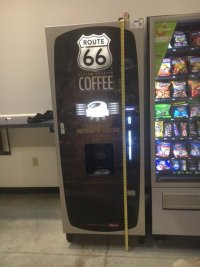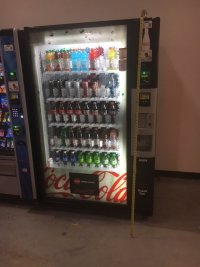Mixed batch of info, hope it helps!
ADA requirements for the vending industry, designating "reach ranges" only, went into effect on March 15, 2012. Ranges can be no higher than 48" and no lower than 15"; side-reach and other accessibility requirements were also revised.
Barbara Elkin, attorney-advisor at the U.S. Department of Justice, explained the new requirements during the government affairs symposium at the National Automatic Merchandising Association (NAMA) OneShow in Chicago.
The regulations establish side reach regulations requiring that all operable parts be no higher than 48 inches and no lower than 15 inches. This differs from the 1991 standards which have controls at 54 inches high and nine inches low.
Elkin noted that it is the vending operators, not the equipment manufacturers, who are responsible for meeting the requirements.
The length of the reach is the main change under the new rules, Elkin noted. "An awful lot of this has not changed" since 1991, she said.
The machine must be easily accessible for persons in wheelchairs.
Operators do not have to replace existing machines with compliant machines at a location unless the location undergoes an alteration. If the location is not upgraded, changed or renovated, there is no need to install new equipment.
In addition, a machine will have to be made compliant if it is altered. A machine is considered altered if the payment mechanism is changed. Normal maintenance to mechanical or electrical systems are not considered alterations, Elkin said.
If an operator has a bank of equipment selling the same products, only one machine in the bank must comply with the rules, Elkin said. If each of the machines are selling different products, then all must comply.
For buildings with machines on different floors, Elkin said the requirements will apply for any machine that serves a different group of consumers in the building.
Elkin said it has not been determined if the accessibility requirements will apply to communication elements on vending machines such as videoscreens. "That may be coming," she said. "Increasingly, we're seeing machines that can do everything."
NAMA has argued that the rules should not apply to vending machines that are not fixed into building since the ADA requirements state they apply only to fixed equipment.
NAMA has submitted comments to the Department of Justice (DOJ) arguing that the ADA requirements do not apply to moveable and non-fixed vending machines. However, until a specific exemption is allowed for vending, NAMA urges operators to meet the requirements.
According to the material Elkin provided at the symposium, if a machine is freestanding, it must still be accessible to persons with disabilities. "Freestanding machines should be made accessible to the maximum extent feasible," the material notes. "DOJ recommends that the ADA Standards be used as a guide for these machines as well."
Elkin said freestanding equipment must nonetheless meet the requirements.
The Supreme Court recently asked the U.S. Department of Justice (DOJ) to weigh in on whether vending machines are places of public accommodation covered by Title III of the ADA. The Court’s request related to a pending a Petition for Certiorari filed by a blind plaintiff who unsuccessfully sued Coca-Cola for allegedly owning and/or operating vending machines that are not independently usable by the blind. Both the District Court and the Fifth Circuit had concluded that such machines are not public accommodations under the ADA.
The DOJ’s amicus brief unequivocally stated its position that vending machines are not public accommodations. The DOJ advanced a number of arguments in support of its position that a vending machine does not fall within any of the 12 categories of businesses that are considered public accommodations under the statute. Among other things, the DOJ stated that a vending machine is not a “sales establishment” covered by the law but rather a piece of equipment typically found within public accommodations facilities.
The most significant commentary from the DOJ’s brief concerns a public accommodation’s obligations with regard to self-service equipment provided for public use. The DOJ stated:
the operator of a public accommodation in which the vending machines is located is better suited to determine whether such changes [(i.e. making the vending machines independently accessible by blind users)] are the most efficient means of complying with the ADA. When buying or leasing vending machines, some business owners may insist upon the inclusion of accessible features. Others, however, might choose instead to install the machines at locations within their establishments where their employees will be available to assist customers with disabilities. The business owner is better positioned than the seller or lessor of the machines to determine what method of ensuring accessibility will be most effective at a particular location.
In other words, it is the DOJ’s position that providing assistance to customers with disabilities is a lawful way to provide access in lieu of procuring accessible vending machines. Presumably this position would extend to all self-service equipment provided for customer use — at least when there are no privacy concerns. (In 2014, the DOJ had filed a Statement of Interest in a different case involving allegedly inaccessible point-of-sale devices where it took the position that a public accommodation must provide individuals with disabilities independent access to point-of-sale devices which require the entry of Personal Identification Numbers (PINs).)
In McGee v. Coca Cola Refreshments USA, Inc., 2015 WL 6620959 (E.D. La. 2015) the court held definitively that a Coca Cola vending machine is not, by itself, a place of public accommodation covered by the ADA. It noted, however, that the bus station in which the machine was located was a place of public accommodation and might well be obligated to provide accessible vending machines. The case was decided early, so there is no guidance as to what accessible means.


 View attachment 3030 View attachment 3031
View attachment 3030 View attachment 3031